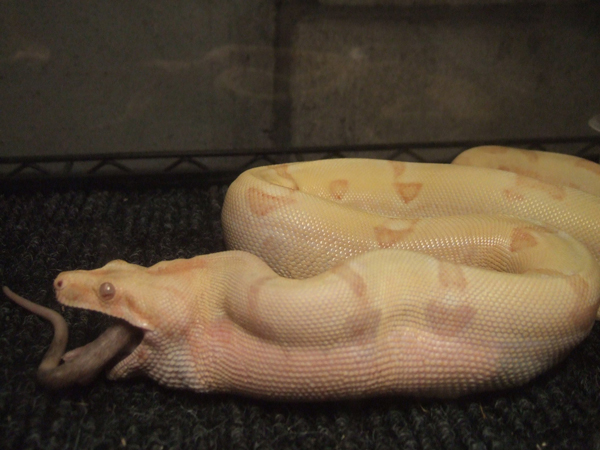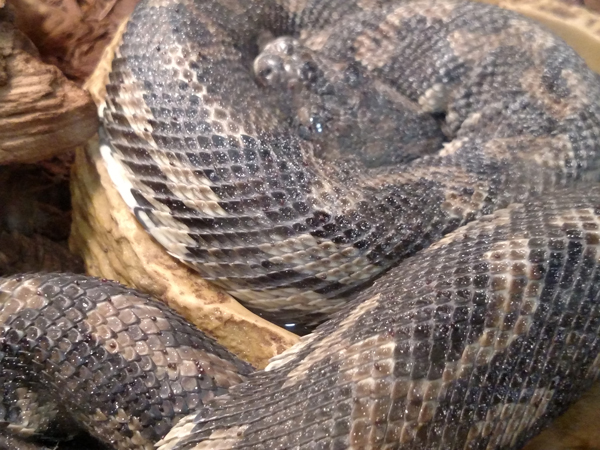Inclusion Body Disease is devastating to the snakes that are infected by it.
To this day I remember my very first actual experience with Inclusion Body Disease or IBD as it is also known. It was in the early 1990s and I was visiting a friend’s herpetological breeding facility. While inspecting his giant snake collection, we happened upon an isolated room which contained a single, very large Neodesha sliding glass front container in which was housed an enormous 18- to 20-foot Reticulated python. What I saw that afternoon is forever etched within my brain.
Although I had owned Retics of my own and had been around some very large specimens, the particular individual that I was currently observing was completely cork screwed from the rear of its head to its tail. I’m not talking about a gentle twist, I mean literal cork screw as in curly fries or fusilli pasta, this snake's body was an actual tight, spiral.

leo spinner
The author's "Sunglow" albino Boa constrictor continued feeding while developing IBD.
As awe-inspiring as the sight of this animal was, it was also rather mortifying to see such an extreme condition and what one would perceive as an animal surely suffering and in great pain. The owner of this unfortunate snake assured me that this condition had been quite gradual and it was not actually born this way. He said it had no difficulty in feeding on pre-killed food and was quite capable of urinating and defecating with no difficulty. At the time, my friend was not 100% sure that this ailment was indeed IBD and I believe he was hopeful that a cure would come along or the snake would ultimately get better on its own.
Although I was fairly well informed of IBD at the time (there was a wealth of chatter on the subject throughout the 1990s) it was still relatively new having only been first identified clinically in the mid-1970s.
What is Inclusion Body Disease (IBD)?
IBD or Inclusion Body Disease is a highly contagious, often life threatening disorder that debilitates specimens which are symptomatic, with uncontrollable muscle contortions. Muscular disfigurement caused by IBD often progresses unrelentingly (often slowly, sometimes swiftly) and ultimately leads to death due to starvation, compromised circulation and/or suffocation often related to pneumonia.
IBD is the result of an internal attack on a Boa constrictor or python by a particular virus known simply as arenavirus, which belongs to the family arenaviridae.
Although some types of arenavirus are known to inflict humans with various disorders, the virus which causes IBD in particular and belongs to the arenavirus genera (of which there are two) reptarenavirus, does not. Members of the other arenavirus genera mammarenavirus, do affect humans and other types of mammals depending on the affliction.
The name arenavirus is derived from the granular inclusions or host cytoplasmic ribosomes which appear in the virus as “arena” like. Inclusion Body Disease arenavirus manifest themselves intra-cellular within the epidermal, mucosal and visceral epithelial cells and neurons of the affected species. Virions are typically pleomorphic and are covered in threads of glycoprotein.
Symptoms of Inclusion Body Disease:
Symptoms of IBD typically do not appear immediately and it is unusual to have a very young snake exhibit symptoms of this disorder. As a snake matures, symptoms typically set in gradually with peculiar head lifting behavior. This head lifting is often referred to as “star gazing” and in the early stages can be confused with normal, curious behavior due to activity outside of the snake’s enclosure or the presence of food. Star gazing is identified when the afflicted animal begins lifting its head and often the first third of its body upward and with a slight backward lean. This motion will often be maintained for several minutes or longer. IBD symptoms become more apparent as the disease gains a firmer hold and ultimately the snake will show signs of losing balance and muscular twisting.
I was given a “sunglow” albino Boa constrictor that was suspected as having had a neurological disorder. The snake was still quite young at a year and a half when acquired and rarely exhibited symptoms. When symptoms would appear, they would be so minute that it was difficult to actually gauge whether the snake was sick or not.
Within the next year, the snake's tail began to twist and the star gazing would last for longer intervals, eventually ending with the snake losing balance and falling backwards. The Boa was humanely euthanized before the age of three.
During the time that I owned the albino Boa constrictor, its behavior outside of the IBD symptoms was normal. The snake would eat, drink, urinate and defecate on a regular basis. It was later learned that the sunglow Boa had originated from a collection that had been badly infested with parasitical mites and although it was cleaned up before I had received it, the damage was apparently done.
Species Affected/Vectors:
To date, it seems that Inclusion Body Disease only affects the Boas and pythons and is not recognized in wild caught animals although it has been suggested by some individuals that the disease may be carried by snakes in nature without obvious physical effects.

leo spinner
A carpet python with a severe infestation of Ophionyssus natricus.
American Boa constrictors seem to be the species from which the IBD virus originated and was later spread to captive reptiles. It is assumed that Boa’s carrying the virus are the sole purpose for IBD in pythons and wild caught pythons do not appear to be asymptomatic carriers of the IBD virus as has been suggested with boas. To date the IBD virus seems to afflict only snakes within the Boa and Python complex and other species kept in collections alongside Boas and pythons have been unaffected.
The IBD virus seems to be directly transmitted by blood, usually by a carrier such as the parasitical reptile mites Ophionyssus natricis.
In private collections containing Boas which developed signs of IBD, other boids within the collection were left unaffected when without the presence of Ophionyssus natricis. Private collections with parasitical mites were more likely to have a wider spread problem of IBD once the disease appeared, presumably due to viral spread via blood-filled mites.
Resolution and prevention:
Sadly speaking, there is no current cure for Inclusion Body Disease and the only resolution seems to be euthanasia of affected stock. It is extremely important to be vigilant in husbandry techniques especially when it comes to cleanliness and quarantining newly acquired animals. There is no turning back once IBD has taken a hold on your collection.
Now with the rise in value of the different boid species due to selective breeding projects along with large scale production, you cannot be too careful.
Where vectors of disease are concerned, preventing parasite infestations in your collection is considerably more effective than trying to eradicate an already established population of parasites. Be very careful of where your snakes are coming from and always isolate new acquisitions. Purchasing your animals from well-known, established professional breeders that keep historical, lineage documentation is a great place to start. Don’t be afraid to ask a breeder questions regarding the history of your acquisition. A respected professional will understand your concerns.
Newly acquired snakes and currently owned snakes should be examined on a weekly basis (some people examine their snakes daily) for parasites and this examination can be easily achieved by simply handling your snakes with hands that are wet. Snake mites will temporarily stick to your wet hands making them easy to view and identify. In the event that snake mites are discovered in your collection, it will be necessary to treat all of the animals within the affected area as if they have mites – whether all of your snakes are showing signs of infestation or not. Treating all of your animals and disinfecting all of their enclosures is not a pleasant experience and should be avoided at all costs! Quarantining new animals is a small sacrifice to make when it comes to the amount of effort you will have to put forth in the long run.


